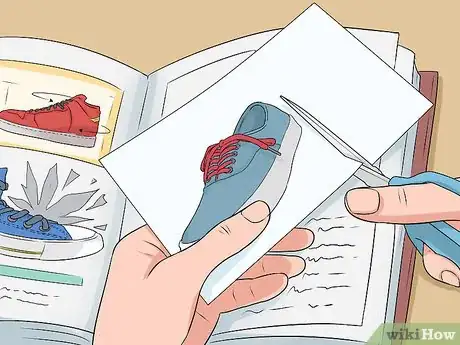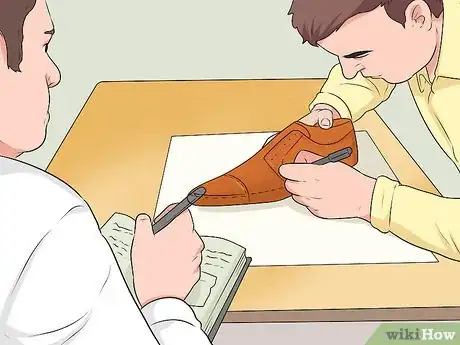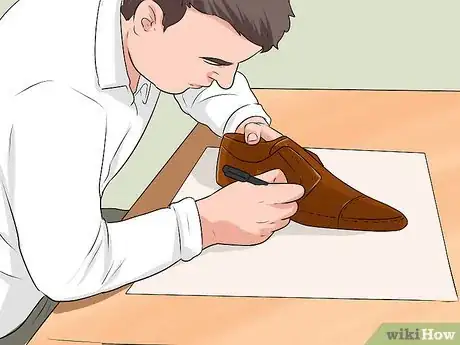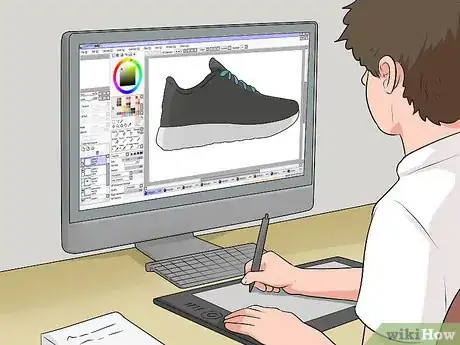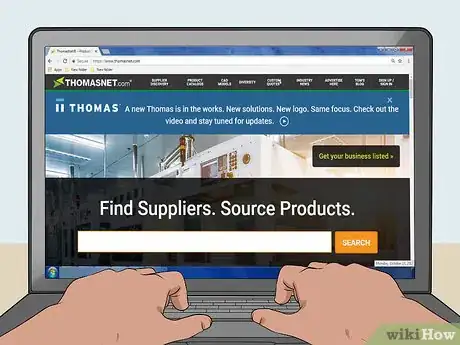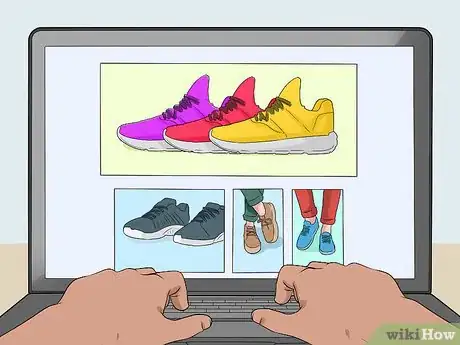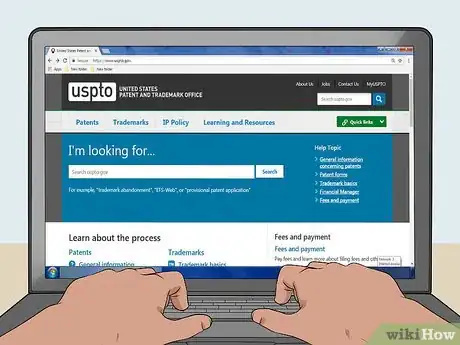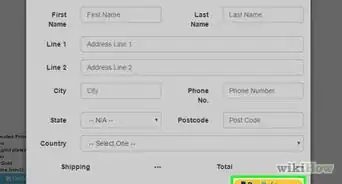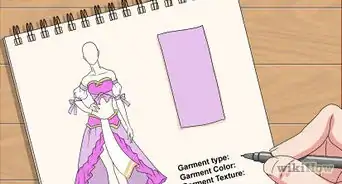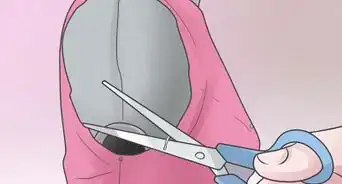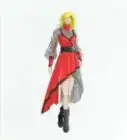This article was co-authored by Miri Rodriguez. Miri Rodriguez is a Business Brand Consultant and the Owner & CEO of Be Mindful Be Happy. She has been coaching business and individual brands for over 15 years in the areas of career development, personal development, branding, and storytelling for impact. She is the best-selling author of the award-winning book Brand Storytelling. She holds a Master’s degree in Integrated Communications and Marketing from Georgetown University and various certifications including Copyrighting, Technical Writing, Design Thinking, Six Sigma, and Prosci Change Management.
There are 14 references cited in this article, which can be found at the bottom of the page.
This article has been viewed 35,544 times.
If you have creative ideas about footwear, you may consider starting your own shoe line. Though undertaking such a large project can be daunting, breaking it down into smaller pieces will help you get organized and realize your dreams. By starting your business, hiring the right team, and creating your brand, you can achieve your entrepreneurial goals in the shoe industry.
Steps
Refining Your Design Ideas
-
1Create a scrapbook of inspirational ideas. Set your shoe line apart by looking for unique inspiration in the world around you. Cut out phrases or images that catch your eye. You can draw inspiration from art, nature, advertising, or even your own imagination.[1]
- Take note of eye-catching shapes and patterns you may want to incorporate into your designs.
- For example, the bark of a tree could inspire a fabric for your shoe design.
-
2Enroll in shoe design classes. Find a class on shoe design at a fashion school or local university to learn more about the shoe industry. Take notes on both the business and artistic sides of shoe design. These classes teach as much about classic designers as they do about manufacturing shoes and running a business.[2]
- Some schools offer intensive classes that can be taken in as little as one year.
- If the class you want is open only to students of the school, contact the registrar and ask about auditing the class for no credit.
- If you’re still making up your mind about your career path, major in fields applicable to shoe design but also other disciplines, such as marketing or business management.
Advertisement -
3Meet with peers to brainstorm. Show your scrapbook to trusted friends and colleagues to get feedback about your design ideas. They can give you valuable opinions to help refine your designs or spark new ideas.
- Not every friend will be able to give solid professional advice. Seek out successful friends or coworkers who tend to give honest feedback.
- If you’re new to the field and don’t have colleagues yet, talk with a professor or friend from class. You can also gain colleagues by applying for an internship in the shoe industry.
Developing a Business Strategy
-
1Save enough money for an initial investment. Take stock of your finances to understand how much you can devote to your dream. You will need an initial sum of money to cover starting an inventory, producing the shoes, and paying a small staff. While there is no technical minimum, experts recommend a starting sum of around $200,000 USD.[3]
- Some successful shoe designers, such as CeCe Chin, have started with less. Chin started her business with $35,000 USD.[4]
- This money will help cover expenses not directly related to shoe design, too, such as transportation and travel costs to meet with collaborators.
- While it’s best to have this money in hand, you can also take out a loan to secure enough money for an initial investment.
-
2Narrow down your target market. After learning more about the shoe industry, narrow the focus of your prospective shoe line. Decide who your customers are and how much money they will be spending on your shoes. Think about what need isn’t being met by the current market that your shoe line will address.[5]
- Although it's important to have a clear understanding of who you're targeting, the reality of new brands is that you have to test the waters to really understand where your customer's needs lie.
- If you’re feeling overwhelmed, ask a couple of friends what they look for in shoes and how much money they would be willing to spend. You can use their feedback to refine who you think your target audience will be.
- Use the price point your target market prefers to begin thinking about shoe materials that make sense.
- When doing market research against your future competitors, try to think as a new consumer. Why would you use their products? What do they offer, good and bad? This will give you a bigger perspective to how and why you would offer your services.
-
3Create a business plan. Outline your business both artistically speaking and financially on paper. Craft the plan professionally so you can use it as a guide to talk to prospective partners and employees (once hired) about the business. Update the plan as necessary, so you can use the document for reference.[6]
-
4Meet with a successful shoe entrepreneur. Reach out to a shoe line creator you met during your classes. If you don’t know any, ask a professor and see if they can help you connect with someone who’s “made it” in your industry. Schedule a short meeting (15 minutes) that is respectful of the person’s time. Ask them for their advice in starting a new business.[7]
- To ask for the meeting, say, “Mrs. Johnson. I’m a student of Professor Fox’s at the Smith School of Design. I admire your work with wedges and how you’ve used direct sales to grow your business. I am looking to start a shoe line of my own and was hopeful we might be able to meet to discuss how you started your business. Perhaps I could bring coffee and chat with you for 15 minutes at your convenience?”
-
5Show up to the meeting prepared. Bring a specific list of questions and dress professionally. Do your homework on the person you are meeting with and show interest in their work. Bring your business plan and any sketches you have in case they ask, but don’t make these the focus of the meeting.
- This is not a collaboration session. It’s an opportunity to learn from someone who has achieved your goal.
- To find out more about how they developed their business, you might ask, “How did you decide you wanted your line to focus on wedges?”
- You might admire their work by saying, “I really appreciate how most of your shoes can be worn both to the office and black-tie events. How did you achieve this balance?
Hiring the Right Team
-
1Find a shoe designer. Locate an experienced shoe designer who can get your design ideas down on paper. Look for someone you get along with who has experience in the fashion industry. The right person may also know other industry professionals who can join your team.[8]
- If you’ll be designing the shoes yourself, you already have this person! If you’ll be hiring a shoe designer, make sure you have a complete idea of your line’s look so you can communicate it clearly.
- Online freelance marketplaces, such as PeoplePerHour.com or UpWork.com, have profiles of available designers with digital portfolios you can view.
-
2Hire a graphic designer. Look for a designer with experience developing patterns for shoes. Your graphic designer will help you develop an online presence and create templates for your manufacturer.[9]
- Graphic designers can be located on freelance marketplaces online.
-
3Find a manufacturer that works with new businesses. Browse online supplier directories to read profiles of different manufacturers that suit the needs of your business. Some manufacturers only work with large or established clients while others specialize in those starting out.[10]
- Online supplier directories based in the U.S include: ThomasNet, Makers Row, MFG, and Kompass.
- Online supplier directories based elsewhere around the world include: Oberlo, Alibaba, AliExpress, IndiaMART, and Bambify.
-
4Find a marketing guru. Enlist a marketing professional who can help you connect with your target audience and advertise your business. Hire someone with experience working in the fashion and shoe industry, so they have a good working knowledge of industry professionals and relevant media outlets.[11]
- Search for a marketing expert on media job boards, such as MediaBistro.
-
5Network with people you know in the business already. Keep in touch with former classmates and mentors throughout the hiring process. They may be aware of professionals in your industry seeking new opportunities. They can help match you with talent that would be a good fit for your business.
-
6Attend local fashion and shoe events to meet industry players. Stay on top of developing trends and new names by going to trunk shows and other shoe events. You can find out about these events at your local department store or fashion school. You may meet likeminded people with good hiring leads or who are looking to collaborate.
- These events can also help you make valuable connections in the retail industry, if you intend on selling your designs in brick-and-mortar department stores.
- Some of these events may be invitation-only. The more connected you are, the more likely you are to be invited.
Creating Your Brand
-
1Name your business. Brainstorm a name for your business. It may help to create word clouds or a bulleted list of potential names. Perhaps you already have it narrowed down to 1 or 2. Ask friends for their opinions about the name to help you refine it.[12]
- Examine your list of names to make sure the name you choose reflects the customers you are hoping to attract.
- If you ask others for their opinion about your names, try not to reveal your own bias, if you have one. They’ll be more likely to give you their honest opinion.
- If you feel stuck, show a friend your business plan and describe your vision. Sometimes having another person there to suggest ideas helps get names flowing.
-
2Create a website. Ask your graphic designer to create a website for you. Test the demo version of the website by clicking on all the links and filling out any forms to make sure they work. Check to see that the site feels intuitive. Write down any tweaks or feedback for your colleague.[13]
- Keep refining the website together until you feel your brand is well-represented.
- Be sure to try any merchandising functions, such as making a purchase, to ensure they work properly.
-
3Create branded materials for your shoes. Work with your graphic designer to develop a company logo, packaging, business cards, and any special signage for your business. The more polished and professional your business appears, the more seriously people will take your shoe line.[14]
-
4Develop a marketing strategy. Work with your marketing professional to get the word out about your new shoe line. You can host a trunk show, run print advertisements, or offer deals to get people talking about your business.[15]
- Draft a press release and send it to editors of local publications so they can help publicize your launch.
-
5Develop a social media presence. Start social media pages for your business on Facebook, Instagram, and Twitter so your customers can connect with you online. You can let customers know of upcoming sales or styles, broaden your customer base, and enhance your business’ image.[16]
- Asking questions is a great way to connect with your customers online. You can ask them their preferences in color for a new style or just engage with the news in a fun way.
-
6Register any trademarks associated with your business. Register your logos, products, and proprietary business imagery with the U.S. Patent and Trademark Office at www.uspto.gov. Before completing your online registration, query the site’s trademark electronic search system to make sure your name and logos are not already taken.[17]
- You can complete this registration online without the help of a lawyer for a fee. Trademark registration costs between $275 and $325 USD.
- If you’re outside the United States, contact your nation’s federal trademark office to register your business appropriately.
Expert Q&A
-
QuestionHow can I make my clothing brand successful?
 Miri RodriguezMiri Rodriguez is a Business Brand Consultant and the Owner & CEO of Be Mindful Be Happy. She has been coaching business and individual brands for over 15 years in the areas of career development, personal development, branding, and storytelling for impact. She is the best-selling author of the award-winning book Brand Storytelling. She holds a Master’s degree in Integrated Communications and Marketing from Georgetown University and various certifications including Copyrighting, Technical Writing, Design Thinking, Six Sigma, and Prosci Change Management.
Miri RodriguezMiri Rodriguez is a Business Brand Consultant and the Owner & CEO of Be Mindful Be Happy. She has been coaching business and individual brands for over 15 years in the areas of career development, personal development, branding, and storytelling for impact. She is the best-selling author of the award-winning book Brand Storytelling. She holds a Master’s degree in Integrated Communications and Marketing from Georgetown University and various certifications including Copyrighting, Technical Writing, Design Thinking, Six Sigma, and Prosci Change Management.
Business Brand Consultant Look really intently at the positioning of your brand in the market. Right now, one of the biggest factors to consider in the fashion industry is how the brand is positioning themselves for sustainability. Most of the fashion industry today is actually greenwashing, or making themselves look more eco-friendly than they actually are. Make sure that there is a sustainability factor that your brand can commit to, and that you're actually making sustainability part of your marketing (rather than just a trend).
Look really intently at the positioning of your brand in the market. Right now, one of the biggest factors to consider in the fashion industry is how the brand is positioning themselves for sustainability. Most of the fashion industry today is actually greenwashing, or making themselves look more eco-friendly than they actually are. Make sure that there is a sustainability factor that your brand can commit to, and that you're actually making sustainability part of your marketing (rather than just a trend). -
QuestionHow do you make your brand reliable?
 Miri RodriguezMiri Rodriguez is a Business Brand Consultant and the Owner & CEO of Be Mindful Be Happy. She has been coaching business and individual brands for over 15 years in the areas of career development, personal development, branding, and storytelling for impact. She is the best-selling author of the award-winning book Brand Storytelling. She holds a Master’s degree in Integrated Communications and Marketing from Georgetown University and various certifications including Copyrighting, Technical Writing, Design Thinking, Six Sigma, and Prosci Change Management.
Miri RodriguezMiri Rodriguez is a Business Brand Consultant and the Owner & CEO of Be Mindful Be Happy. She has been coaching business and individual brands for over 15 years in the areas of career development, personal development, branding, and storytelling for impact. She is the best-selling author of the award-winning book Brand Storytelling. She holds a Master’s degree in Integrated Communications and Marketing from Georgetown University and various certifications including Copyrighting, Technical Writing, Design Thinking, Six Sigma, and Prosci Change Management.
Business Brand Consultant Only make commitments for the future that you're going to be able to fulfill. Don't just say "I'm going to make a promise and people are going to forget about it"—instead, really commit to actionable items and talk about them as part of your brand strategy. For instance, in the fashion industry, it's important to share actionable ways your brand is committed to sustainability.
Only make commitments for the future that you're going to be able to fulfill. Don't just say "I'm going to make a promise and people are going to forget about it"—instead, really commit to actionable items and talk about them as part of your brand strategy. For instance, in the fashion industry, it's important to share actionable ways your brand is committed to sustainability.
Expert Interview
Thanks for reading our article! If you'd like to learn more about starting a business, check out our in-depth interview with Miri Rodriguez.
References
- ↑ https://www.ft.com/content/edc3baba-4e27-11e4-bfda-00144feab7de
- ↑ http://www.istitutomarangoni.com/en/fashion-courses/undergraduate-programmes/one-year/shoe-design-intensive/
- ↑ https://www.thebillfold.com/2014/10/how-to-make-your-own-shoe-line/
- ↑ https://www.thebillfold.com/2014/10/how-to-make-your-own-shoe-line/
- ↑ https://www.inc.com/guides/2010/06/defining-your-target-market.html
- ↑ https://www.inc.com/david-finkel/a-powerful-7-part-outline-to-create-your-business-plan.html
- ↑ https://www.forbes.com/sites/sabinanawaz/2015/11/07/9-tips-to-land-a-great-mentor-how-to-ask-a-stranger-for-career-advice/#7fd9eafd10fe
- ↑ https://www.youtube.com/watch?v=T8XTZGzBBB4
- ↑ https://www.youtube.com/watch?v=T8XTZGzBBB4
- ↑ https://www.shopify.com/blog/13975985-how-to-find-a-manufacturer-or-supplier-for-your-product-idea
- ↑ https://www.youtube.com/watch?v=T8XTZGzBBB4
- ↑ https://www.entrepreneur.com/article/21774
- ↑ https://www.forbes.com/sites/allbusiness/2013/12/10/key-steps-to-building-your-small-business-website/
- ↑ https://www.shopify.com/blog/16991592-how-to-create-a-memorable-and-shareable-unboxing-experience-for-your-brand
- ↑ https://www.forbes.com/sites/advisor/2013/04/17/creating-a-successful-marketing-strategy/
- ↑ https://sproutsocial.com/insights/building-social-media-presence/
- ↑ http://guides.wsj.com/small-business/starting-a-business/how-to-trademark-a-company-name/
